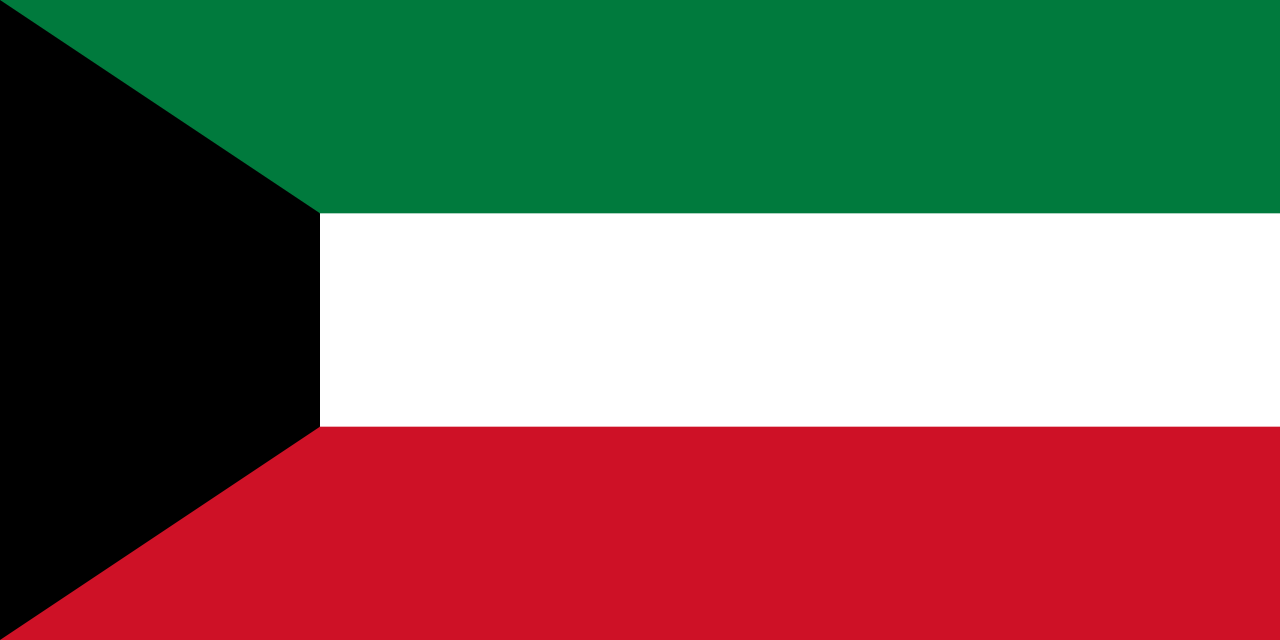Green Stripe:
At the zenith of the flag lies a vibrant green stripe, reverently embodying Kuwait's Islamic heritage. This verdant hue serves as a potent emblem of Islam's profound influence in the lives of Kuwaitis, representing their unwavering commitment to the teachings and principles of the faith. Moreover, the green evokes imagery of burgeoning growth, fecundity, and the lush, life-giving oases and palm groves that have historically been at the heart of Kuwait's captivating landscape and vital sustenance.
White Stripe:Nestled gracefully in the middle, the pristine white stripe carries profound connotations of purity and serenity. It is a powerful representation of Kuwait's resolute dedication to peaceful coexistence and diplomatic harmony. Symbolically, the white expanse embodies the harmonious intermingling of diverse ethnic and religious groups within Kuwaiti society, poignantly reflecting the nation's unique tapestry of multiculturalism and its embrace of pluralism. Additionally, the color white encapsulates the fervent aspiration for an undisturbed, prosperous future.
Red Stripe:The crimson ribbon, gracefully adorning the base of the flag, stands as an emblematic tribute to Kuwait's arduous journey towards freedom, autonomy, and self-determination. This striking red hue, a beacon of strength, determination, and valor, encapsulates the indomitable spirit of the Kuwaiti populace. Through its vibrant shades, it signifies the resilience and unwavering courage exhibited by the Kuwaiti people in the face of formidable challenges, embodying their triumphant struggles for independence and sovereignty.
Historical Context:Independence and Adoption:
On the pivotal date of September 7, 1961, a moment of profound significance, Kuwait formally embraced the current flag design. This historic act occurred in the immediate aftermath of Kuwait's emancipation from British protection, marking the culmination of its long-fought endeavor for full sovereignty. The adoption of this emblematic flag was a pivotal step, symbolizing Kuwait's metamorphosis from a British protectorate into an independent nation.
Transition from Previous Flags:Before the emergence of the current flag, Kuwait's banners underwent various iterations, including a red flag embellished with elegant white Arabic calligraphy, eloquently displaying the country's name. The shift to the contemporary design was a deliberate, introspective choice that epitomized Kuwait's dynamic evolution, encapsulating its emerging identity and ambitious aspirations as an autonomous, self-determining nation.
Cultural and National Significance:Unity in Diversity:
The meticulously crafted tri-color configuration of the Kuwaiti flag is a profound reflection of the nation's ethos of unity amidst diversity. Serving as a captivating mosaic, it unites disparate ethnicities such as Arabs, Persians, South Asians, and other communities. This emblem of unity serves as a powerful reminder that despite varying cultural backgrounds, Kuwaitis stand united under a shared national identity, collaboratively striving for the advancement and prosperity of their beloved land.
National Pride and Identity:The flag burgeons with deep-seated national pride and identity, embodying the heart and soul of the Kuwaiti people. It unfurls majestically on a multitude of occasions, from solemn national holidays to exuberant celebratory gatherings. As Kuwaitis raise their flag, it is a gesture laden with reverence, a visual testament to their unwavering loyalty to their nation and a tangible manifestation of their profound respect for the storied history that has shaped their collective identity.
International Representation:Beyond national boundaries, the Kuwaiti flag unfurls as a universal symbol of the nation's values and interests. Displayed prominently at Kuwaiti embassies, consulates, and international events, it encapsulates the nation's global presence and underscores its commitment to diplomacy, cooperation, and its role on the world stage.
Social and Cultural Representation:The vivid colors of the Kuwaiti flag have transcended mere symbolism, permeating myriad facets of Kuwaiti society. These hues are interwoven into the very fabric of tradition, as they grace traditional attire, adorning garments worn during cultural festivities, momentous weddings, and other ceremonial occasions. Additionally, the flag's palette resonates within the realm of art and architecture, painting a vivid picture of Kuwait's cultural vibrancy.
In summation, the Kuwaiti flag is far more than a mere insignia; it is a living embodiment of the nation's chronicle, its present aspirations, and its future potential. Rooted in a rich tapestry of symbolism, historical significance, and cultural depth, the flag encapsulates Kuwait's Islamic heritage, its unyielding pursuit of peace, its valiant quest for independence, the unity found in diversity, and the profound pride carried by its people. Serving as a unifying beacon, the Kuwaiti flag fosters an unbreakable bond of patriotism and identity amongst Kuwaitis, while simultaneously showcasing the nation's cherished values to the global community.
Last Updated on: August 18, 2025
